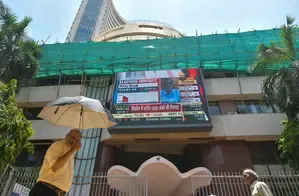Why Did the Sensex and Nifty Close Lower Amid Weak Global Trends?

Synopsis
Key Takeaways
- Sensex fell by 592.67 points to close at 84,404.46.
- Nifty declined by 176.05 points to settle at 25,877.85.
- Investor sentiment remains cautious amid US-China trade talk uncertainty.
- Most sectoral indices ended in the red.
- L&T emerged as the top gainer with a 0.91 percent rise.
Mumbai, Oct 30 (NationPress) The Indian stock markets experienced a significant downturn on Thursday, influenced by weak global indicators after the US Federal Reserve implemented an anticipated interest rate cut but signaled that this might be the last reduction for 2025.
Investor sentiment remained cautious ahead of new developments in the US-China trade discussions.
The Sensex dropped by 592.67 points, or 0.7 percent, closing at 84,404.46, while the Nifty fell by 176.05 points, or 0.68 percent, settling at 25,877.85.
“The Nifty struggled to maintain higher levels, with ongoing selling pressure pushing it lower. Technically, the Nifty has established an immediate support zone near 25,800, with resistance around 26,000,” analysts reported.
Among the constituents of the Sensex, Larsen & Toubro (L&T) emerged as the top performer, increasing by 0.91 percent. Other gainers included BEL, Maruti Suzuki, Adani Ports, and Titan.
In contrast, major laggards like Bharti Airtel, Power Grid, Tech Mahindra, Infosys, and Bajaj Finance each dropped by over 1 percent.
The broader market also reflected mixed trends, with the Nifty MidCap 100 index declining by 0.09 percent and the Nifty SmallCap 100 dropping by 0.1 percent.
Most sectoral indices closed in the negative territory, except for Nifty Energy, which managed to maintain its positive stance.
The Nifty Financial Services index fell by 0.7 percent, alongside declines in IT, Auto, Metal, Pharma, Bank, and Oil & Gas sectors.
“As anticipated, the US Fed reduced interest rates by 25 basis points. However, following Powell's remarks suggesting this could be the last cut of 2025, the market consolidated, diminishing expectations of additional monetary easing,” analysts noted.
They added that the resultant strength of the US dollar fostered a risk-off sentiment across emerging markets, including India.
“Additionally, investors remain vigilant regarding the Trump–Xi trade negotiations, as the ongoing uncertainty surrounding these discussions continues to suppress market sentiment,” experts commented.









